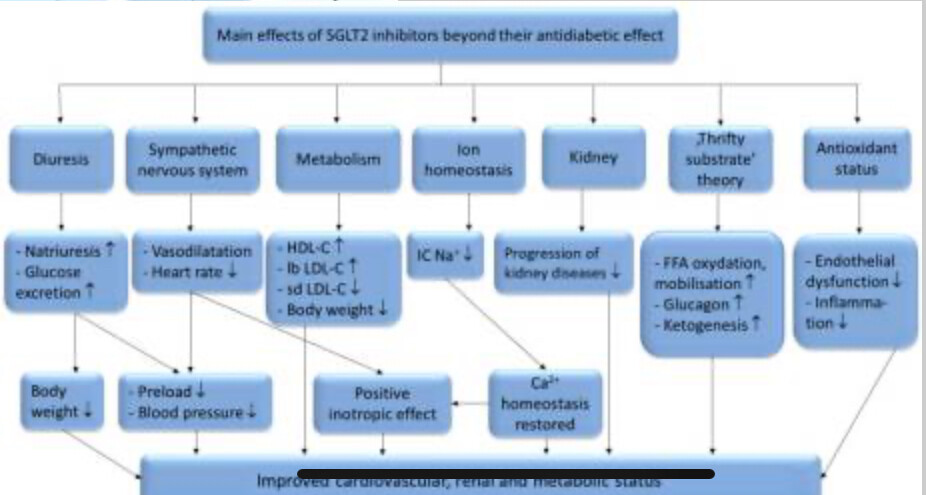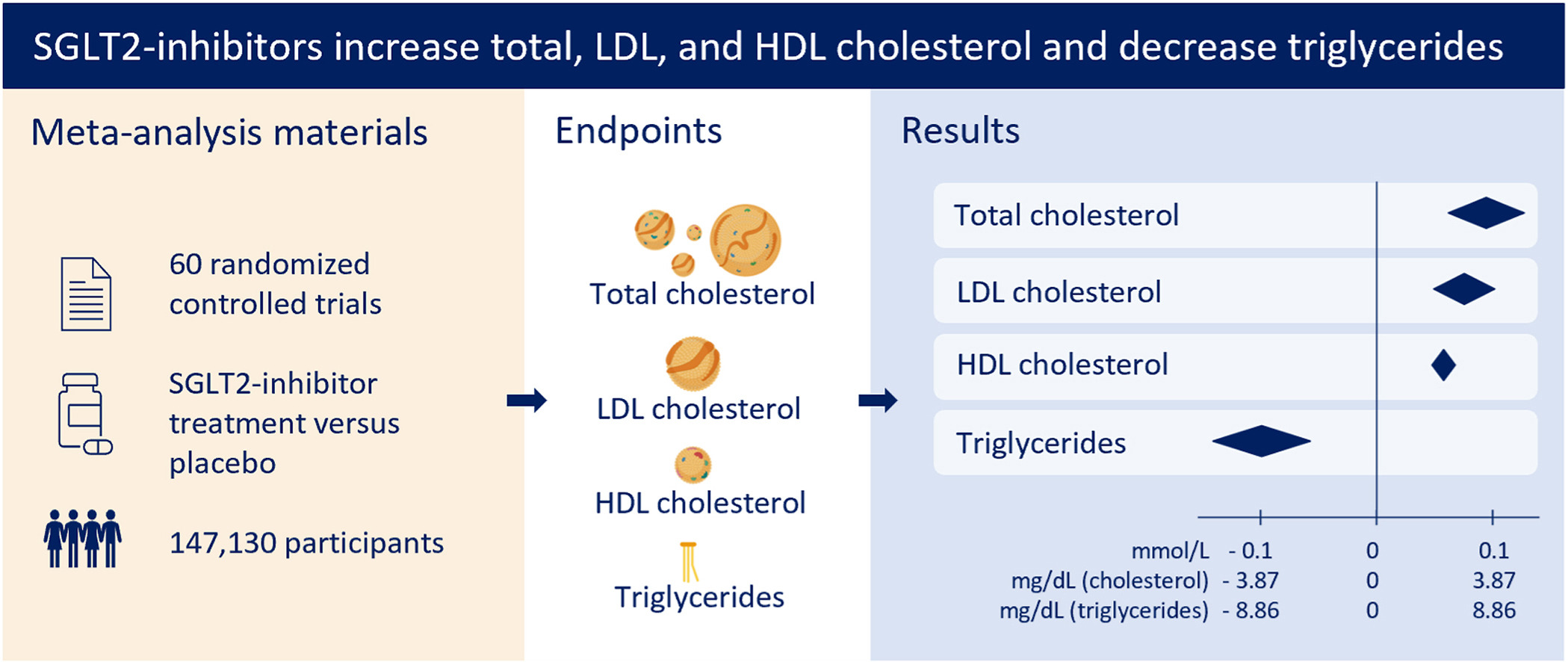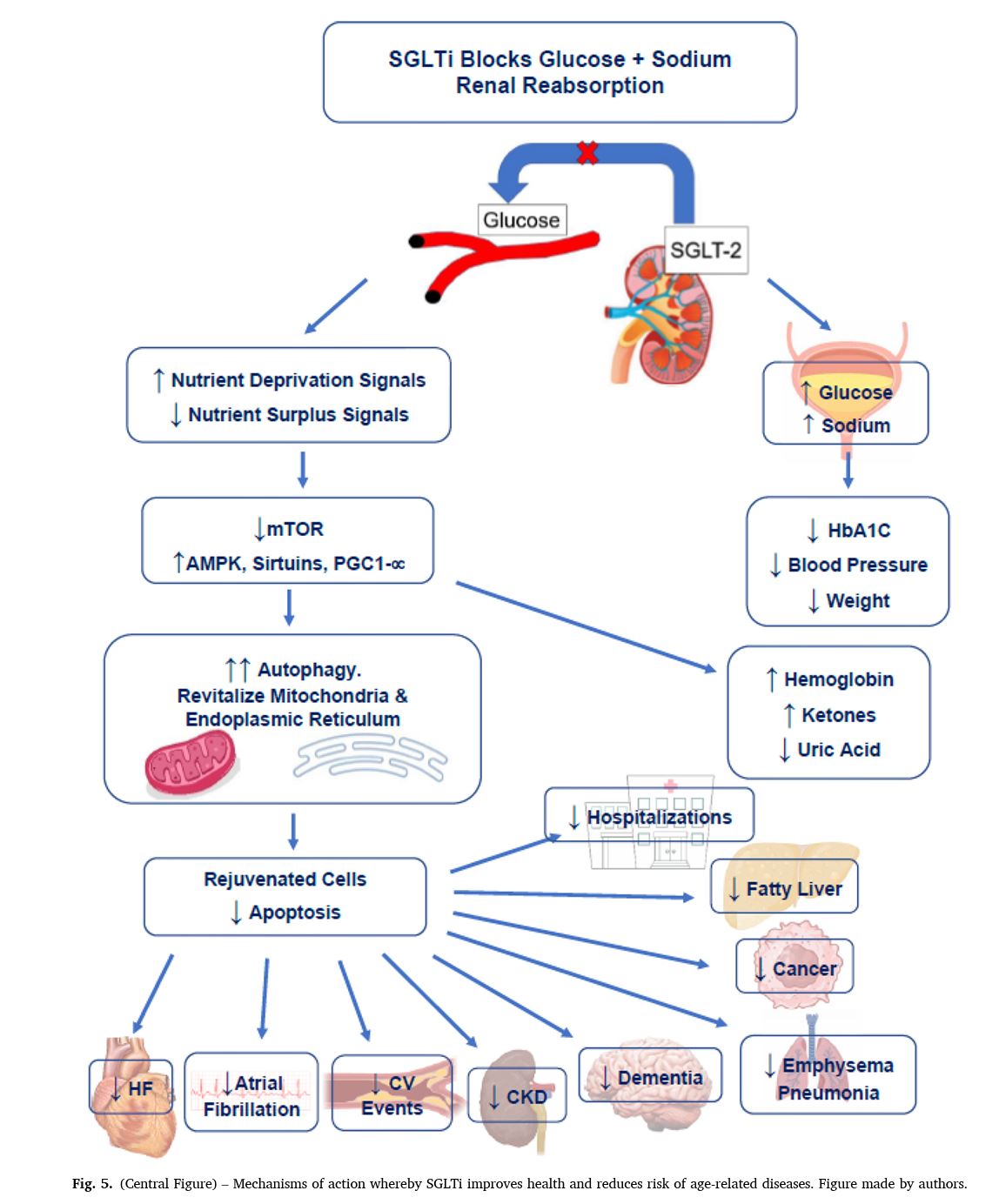I still take Canagliflozin occasionally if I am having a particularly high-carb meal.
Since I exercise, use time-restricted feeding, and have a current calculated BMI of 21.6, I am not sure there would be any particular benefit for me in taking it more often.
Upregulating Sirt1 would seem more beneficial to me. I of course could be wrong.
Yes - saying I think it might impact Sirt1 (and other not just glucose-lowering longevity pathways):
www.ahajournals.org/doi/full/10.1161/CIRCHEARTFAILURE.120.007197
And
By promoting a nutrient deprivation state, SGLT2 inhibitors upregulate the energy deprivation sensors AMPK and SIRT1, inhibit the nutrient sensors mTOR and insulin/IGF1, and modulate the closely linked hypoxia-inducible factor (HIF)-2α/HIF-1α pathways.
And
In overnutrition diseases, SGLT2 inhibitors affect the autophagy via various signaling pathways, including mammalian target of rapamycin (mTOR), sirtuin 1 (SIRT1), and hypoxia-inducible factor (HIF) pathways.
Empagliflozin improves kidney senescence induced by D-galactose by reducing sirt1-mediated oxidative stress
Sodium-glucose cotransporter-2 (SGLT-2) inhibitors have received widespread attention because of their significant protective effects on the kidney. Previous studies have shown that Sirt1, as which is an antiaging protein, is closely related to the maintenance of redox homeostasis. The goal of this study was to determine whether empagliflozin could ameliorate D-galactose-induced renal senescence in mice, and examine the possible mechanisms of Sirt1. We constructed a rapid ageing model in mice by administering D-galactose. An ageing model was constructed by treating cells with high glucose. Treadmill and Y-maze tests were used to assess exercise tolerance and learning memory ability. Pathologically stained sections were used to assess kidney injury. Tissue and cell senescence were evaluated by senescence-associated β-galactosidase staining. The expression levels of P16, SOD1, SOD2 and Sirt1 were detected by immunoblotting. D-gal-treated mice exhibited significant age-related changes, as measured by behavioural tests and ageing marker protein levels. empagliflozin alleviated these ageing manifestations. In addition, Sirt1, SOD1 and SOD2 levels were downregulated in model mice and upregulated by empagliflozin treatment. Empagliflozin had similar protective effects at the cellular level, and these effects were reduced by the Sirt1 inhibitor. Empagliflozin has an antiaging effect, which may be related to reducing Sirt1-mediated oxidative stress.
Paywalled article:
Thank you for those studies, the “Geroscience Repurposing” review article is fantastic. Here it is again for anyone who didn’t see it.
Introduction Relationships between glycemic-lowering effects of sodium glucose co-transporter 2 inhibitors and impact on kidney and cardiovascular outcomes are uncertain.
Conclusions The glycemic effects of canagliflozin are attenuated at lower eGFR but effects on kidney and cardiac end points are preserved. Non-glycemic effects may be primarily responsible for the kidney and cardioprotective benefits of canagliflozin.22
TheracosBio launches lowest cost SGLT2 inhibitor Brenzavvy
US drug developer TheracosBio today announced that Brenzavvy (bexagliflozin), an approved oral sodium-glucose cotransporter 2 (SGLT2) inhibitor, is now available by prescription through the Mark Cuban Cost Plus Drug Company, a pharmacy benefit manager (PBM).
One 30-day supply of Brenzavvy is available for $47.85 plus shipping and handling, which TheracosBio says is the lowest price for any SGLT2 inhibitor on the market. In comparison, all other brand-name SGLT2 inhibitors on the market are priced at rates in the hundreds of dollars per month, with some 30-day prescriptions approaching $600 per month. TheracosBio’s business model is specifically designed to deliver effective medications for prevalent diseases while translating cost savings to patients.
SGLT2 Inhibitors in Aging-Related Cardiovascular Disease: A Review of Potential Mechanisms
Population aging combined with higher susceptibility to cardiovascular diseases in older adults is increasing the incidence of conditions such as atherosclerosis, myocardial infarction, heart failure, myocardial hypertrophy, myocardial fibrosis, arrhythmia, and hypertension. sodium–glucose cotransporter 2 inhibitors (SGLT2i) were originally developed as a novel oral drug for patients with type 2 diabetes mellitus. Unexpectedly, recent studies have shown that, beyond their effect on hyperglycemia, SGLT2i also have a variety of beneficial effects on cardiovascular disease. Experimental models of cardiovascular disease have shown that SGLT2i ameliorate the process of aging-related cardiovascular disease by inhibiting inflammation, reducing oxidative stress, and reversing endothelial dysfunction. In this review, we discuss the role of SGLT2i in aging-related cardiovascular disease and propose the use of SGLT2i to prevent and treat these conditions in older adults.
I’m in the Empagliflozin camp. I tried it for several months and it was quite effective at keeping my fasting blood sugar low. After I ran out I didn’t re-order. Since I don’t have type 2 diabetes, I am just trying different ways to keep my blood sugar lower than it is. The next combo that I am trying is linagliptin and acarbose. If that isn’t sufficient, I will add Empagliflozin.
Also:
“In conclusion, linagliptin and empagliflozin may be promising MARK4 inhibitors, which can further be exploited as potential lead molecules against MARK4-directed neurodegenerative diseases.”
“MARK4 is involved in several malignancies, including, diabetes mellitus, cancer and neurodegeneration. Repurposing approved drugs provides an alternative approach to developing safe and effective therapeutics against rapidly emerging diseases.”
“reductions from baseline in HbA1c were significantly greater with empagliflozin 10 mg/linagliptin 5 mg compared with the individual components but were not significantly different with empagliflozin 25 mg/linagliptin 5 mg compared with the individual components”
Generative AI is experimental. Info quality may vary.
"Empagliflozin is cheaper and more cost-effective than canagliflozin. Empagliflozin costs less and has higher quality-adjusted life years (QALYs) than canagliflozin.
Empagliflozin also has a lower incremental cost-effectiveness ratio (ICER) than dapagliflozin.
However, dapagliflozin-SoC is the most cost-effective strategy.
Empagliflozin is more effective than canagliflozin in reducing the risk of hospitalization for heart failure or cardiovascular mortality in patients with Type 2 diabetes.
https://pubs.acs.org/doi/full/10.1021/acsomega.2c06634
Cost-effectiveness of empagliflozin versus canagliflozin, dapagliflozin, or standard of care in patients with type 2 diabetes and established cardiovascular disease - PMC(cost,versus%20dapagliflozin%20and%20SoC%2C%20respectively.
So far it looks like dapa > empa > cana wrt high efficacy for broad-spectrum protection and lower adverse events in the review studies I’ve seen. Curious if anyone has seen something different.
Canagliflozin and possible neuroprotective mechanisms.
SGLT2 inhibitors and lung cancer:
Lung cancer is the most common form of cancer worldwide and is, by far, the leading cause of cancer deaths. Non-small cell lung cancer (NSCLC) accounts for over 80% of lung cancer cases in the U.S. and, when first diagnosed at a metastatic stage, has a horrific survival of less than a year for 26% of patients. Identifying treatments that can increase survival for this menacing disease is thus of the utmost importance, and one potential avenue toward this goal has been identified from among existing treatments for another deadly disease, type 2 diabetes (T2D). In particular, the class of anti-diabetic drugs known as sodium-glucose cotransporter 2 (SGLT2) inhibitors may show promise for its ability to reduce mortality rates for NSCLC, as indicated by a recent observational study by Luo et al.
Just that Cana seems to be the one used in the rodent longevity studies and not the other ones (which may or may not be important if longevity is your goal, eg I believe I recall that Cana has a bit more SGLT1i in addition to the SGLT2i that they all share).
Vitamin D deficiency appears to render people more vulnerable to canagliflozin’s adverse effects on bone health, whereas vitamin D3 supplementation appears protective of individuals with vitamin D deficiency.
Interesting overview of SGLT2 inhibitors types and effects.
SGLT2-inhibition increases total, LDL, and HDL cholesterol and decreased triglycerides. Effect sizes varies slightly by drug dose and ethnicity but are generally robust by drug type
https://x.com/ATHjournal/status/1711358851025686542?s=20
https://www.atherosclerosis-journal.com/article/S0021-9150(23)05153-5/fulltext
What about taking a large dose of empaglifozin with a large dose of acarbose as a non diabetic for longevity? currently taking empa 25 and might move up from my acarbose 50. Hopefully these drugs are more about bringing glucose to normalcy than too low
Thanks. Note that the papers intro sections included this synthesis, so a bit different flavor.
Highlights
-
SGLT2-inhibitor treatment increases total, LDL, and HDL cholesterol slightly.
-
SGLT2-inhibitor treatment lowers triglycerides slightly.
-
Higher vs. lower treatment dose had minimal influence on the results.
-
Results were generally robust across different types of SGLT2-inhibitors.
-
Overall, changes were modest and not likely to be of clinical relevance.
—
Personally, after the recent Peter Attia conversation with a top urologist, and my inference, my main concern with SGLT2i is the risks of infections (which are perhaps less common in younger men, but in older men or women seem higher, and in men while more rare on average seem like often a bigger issue than in women when they do occur).
SGLT inhibitors for improving healthspan and lifespan
Sodium-glucose cotransporter inhibitor (SLGTi), initially approved as a glucose-lowering therapy for type 2 diabetes is associated with decreased risks for many of the most common conditions of aging, including heart failure, chronic kidney disease, all-cause hospitalization, atrial fibrillation, cancer, gout, emphysema, neurodegenerative disease/dementia, emphysema, non-alcoholic fatty liver disease, atherosclerotic disease, and infections. Studies also suggest SLGTi improves overall life expectancy and reduces risks of cardiovascular disease death and cancer death. These wide-ranging health benefits are largely unexplained by the modest SLGTi -induced improvements in standard risk factors. SLGTi produces upregulation of nutrient deprivation signaling, while simultaneously triggering downregulation of nutrient surplus signaling. This in turn promotes autophagy—cellular housekeeping whereby senescent and damaged organelles are broken down and recycled, which helps to maintain cellular integrity and prevent apoptotic cell death. SLGTi decreases oxidative stress and endoplasmic reticulum stress, restores of mitochondrial health, stimulates mitochondrial biogenesis, and diminishes proinflammatory and profibrotic pathways. These actions help to revitalize senescent cells, tissues, and organs. Their cumulative effects in preventing premature disease and death suggest that SLGTi may slow aging and improve life expectancy, and its mechanisms of action lend strong biological plausibility to this hypothesis. Further randomized trials are warranted to test whether SLGTi —a safe and well-tolerated, once-daily pill, might improve lifespan and healthspan.
Adverse effects
Any candidate compound being considered for use as a geroprotective agent to improve life expectancy should meet the Primum non nocere (first do no harm) maxim. A compound to be used for decades by healthy people must have very low risk for serious adverse effects. SLGTi are generally well tolerated, with discontinuation rates in RCTs that are similar to placebo (Fig. 4). A network meta-analysis of 47,000 patients in RCTs reported no significant changes in the risk of adverse events
Published online, 17 October 2023
https://www.sciencedirect.com/science/article/abs/pii/S0033062023001068
Antidiabetic Drugs May Prevent Kidney Damage
Introduction: Sodium-glucose cotransporter 2 inhibitors (SGLT2i) are a class of drugs that act as glucose reducers in patients with type 2 diabetes mellitus. Recent meta-analyses have shown that SGLT2i also prevent acute kidney injury (AKI) in diabetic patients. The aim of this study was to investigate the protective effect of canagliflozin an SGLT2i on AKI due to ischemia and reperfusion (I/R) in non-diabetic rats. Methods: Male Wistar rats weighing 250-300 g were divided into four groups: Control; SHAM (rats submitted to surgical simulation of renal ischemia); I/R: rats submitted to renal ischemia (bilateral clamping of the renal hilum for 30 minutes); CANA+I/R: I/R rats that received canagliflozin (30mg/kg, oral, gavage; 5 days before I/R). Renal function parameters were evaluated (serum creatinine [CrS]
Results: The I/R group showed an increase in CrS and a reduction in inulin clearance, while the CANA+I/R group showed a reduction in serum creatinine and an increase in inulin clearance compared to the I/R group. In addition, the CANA+I/R group showed a decrease in oxidative metabolites (FOX and TBARS) and an increase in Nrf2 compared to the I/R group. Conclusion: Canagliflozin treatment prevented the reduction in renal function induced by ischemia and reperfusion. In addition, there was a reduction in oxidative activity due to a decrease in oxidative metabolites and urinary peroxides and an increase in renal tissue thiols and Nrf-2, which is responsible for transcribing antioxidant activity. Therefore, the current study confirmed a relevant renoprotective effect of canagliflozin in the presence of renal ischemia.
Maria de Fatima Fernandes Vattimo, Eloiza Oliveira Silva, Sara Ventura, Camila Lima, Jessica Garcia, Alessandra Oliveira Maia, Juliana Veloso Gusmão, Guilherme Henrique Ferreira Vieira and Carla Djamila de Pina Victoria
bioRxiv. posted 22 October 2023, 10.1101/2023.10.19.563071
Brenzavvy (bexagliflozin) has an obvious cost advantage, especially when obtained locally, over other SGLT2 inhibitors.
Has there been a comprehensive analysis comparing the overall efficacy of bexagliflozin, particularly considering its potential longevity benefits, with Cana and Jardiance?



